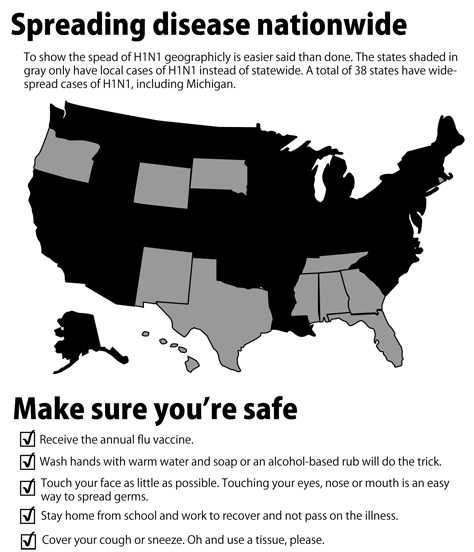Sniffle. Cough. Slow wipes of the nose with sweatshirt sleeves. Heads rest on desks, moaning slightly. You move marginally forward in your chair, thinking of the germs affixing themselves to your back. Thick breaths. Is it rude to look back? Maybe they’ll take the hint and use a cough drop… It’s probably just a harmless cold. Although these symptoms are associated with the common cold, they also correlate with influenza (the flu).
According to the Centers for Disease Control and Prevention, approximately 5 to 20 percent of American citizens get the flu each year. There are multiple strains of the flu, this year the most common one is H1N1.
“H1N1 is a pandemic strain of flu that was introduced to Michigan in 2009,” said Angela Minicuci, Public Information Officer for the Michigan Department of Community Health. “This is one particular strain that really seems to severely impact young adults, unlike the other strains of flu which typically tend to be more severe in seniors or young children. It’s just a common flu strain in our environment now, and seems to be the one that is spreading the most this season.”
Although there isn’t a way to predict which flu strain will be most severe each year, there is a flu vaccine that is an authentic assist as to what can be foreseen in the environment. What the flu vaccine is based on is an accurate assumption for the upcoming season.
“We do have H1N1 in the flu vaccine, and we did anticipate we might see a few cases of it this year,” Minicuci said. “Once you get a flu strain that is highly prevalent in one community, you have a good chance of it spreading very quickly to others- which is really what it’s lead to this season.”
As of last month, 169 positive flu cases have been confirmed, however that number is a gross underestimation of the total number of cases of flu in the state.
“The majority of cases go unreported or undetected, meaning a lot of people just don’t go to the doctor- they don’t get a test to confirm whether or not they have the flu,” Minicuci said. “But we generally use the number of cases that we have as an indicator for whether or not the cases seem to be increasing in the entire state of Michigan.”
There were 12 lab-confirmed flu cases in Ottawa County between Oct., 2013 and Jan. 14, 2014.
“Flu has already come to Michigan this season, causing an unusually high number of severe cases and hospitalizations for this time of year,” said Dr. Matthew Davis, Chief Medical Executive with the Michigan Department of Community Health. “Vaccination is a very effective way to protect ourselves and our communities against flu every year. We expect this is just the beginning of the flu season that will likely last for the next few months. That means that now is the best time for Michiganders to get vaccinated against flu.”
Flu season is typically throughout October to May, peaking between late January to early February.
“This is right about the time of year we would begin to see cases increase,” Minicuci said. “I wouldn’t say H1N1 is any different than any other strain of flu at this time. In 2009 it was a new strain that we hadn’t seen before. There wasn’t a vaccine available, so we saw a lot of cases of it. Now the seasonal flu vaccine contains a strain of H1N1 that will protect you against it. This just seems to be a higher year for H1N1.”
Michigan is ranked 42nd in the nation for flu vaccine coverage. 9 percent of residents age 18 to 24 were vaccinated.
The latest numbers indicate that there have been over 8,190 flu-related absences in Ottawa County schools.
Jennifer Hegel, Infection Control Coordinator at North Ottawa Community Hospital said that the flu often occurs more in younger people because they aren’t getting vaccinated.
“One of the things that we are very concerned about is that this particular age group has very low flu vaccine rates,” Minicuci said. “They’re very unlikely to get a flu vaccine. It’s really important, especially this season, that people go out and get their flu shot.”
Flu strains have a variety of different origins, coming from multiple types of animals. H1N1 was originally nicknamed “swine flu” due to the virus’ genes corresponding with similar influenza germs found in North American pigs. However, a further study concludes that two of these genes are most commonly found in pigs from Europe and Asia, the other genes tracing back to bird genes and human genes.
“Viruses are always circulating and they mutate, which makes them change, so there is no certain origin.” Hegel said.
The flu is a respiratory disease, with a range of symptoms. Usual signs of contamination include having a fever, cough or a sore throat, any kind of runny or stuffy nose, body aches, headaches and fatigue.
Senior Seth Burton was diagnosed with H1N1 during the 2009-2010 flu season. His first symptoms started out with a fever and nausea.
Burton did not get the flu vaccine that season, but now does with the arrival of each contamination period.
“I would say that even if you typically don’t get sick, it’s a good idea to get (the vaccine) it can’t hurt to get it,” Burton said.
District nurse Brandi Buschlen believes that the flu vaccine is the best form of prevention against the H1N1 virus.
“When more people get vaccinated, the less flu can spread throughout that community.” Buschlen said.



